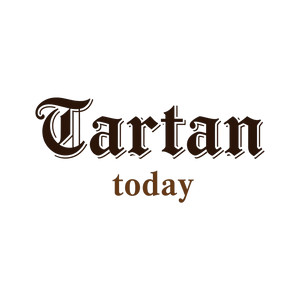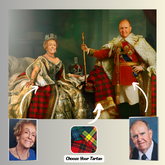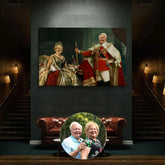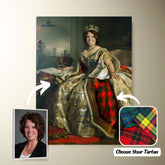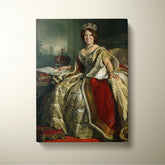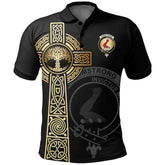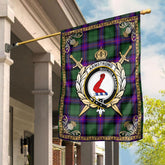-
Personalized Clan Armstrong Ancient Tartan Bagpipe Ornament with Custom Name – Scottish Christmas Tree Decoration TQ32
Personalized Clan Armstrong Ancient Tartan Bagpipe Ornament with Custom Name – Scottish Christmas Tree Decoration TQ32Celebrate your Scottish heritage with this unique wood & acrylic tartan ornament. Perfect as a personalized Christmas decoration or a meaningful gift for friends and relatives on special occasions...- From $19.99 USD
$25.99 USD- From $19.99 USD
- Unit price
- per
Save $6.00 -
Personalized Clan Armstrong Modern Tartan Bagpipe Ornament with Custom Name – Scottish Christmas Tree Decoration PL72
Personalized Clan Armstrong Modern Tartan Bagpipe Ornament with Custom Name – Scottish Christmas Tree Decoration PL72Celebrate your Scottish heritage with this unique wood & acrylic tartan ornament. Perfect as a personalized Christmas decoration or a meaningful gift for friends and relatives on special occasions...- From $19.99 USD
$25.99 USD- From $19.99 USD
- Unit price
- per
Save $6.00 -
Clan Armstrong Family Tartan 2D T-shirt LO43 - Black
Armstrong Family Tartan Clan 2D T-shirt LO43 Product detail: This new 2D t-shirt features a relaxed fit for Men and Women, durable, breathable and soft Made from 100% cotton The High-resolution graphic artwork is printed on the entire shirt. Machine wash cold. The print...- $29.25 USD
- $29.25 USD
- Unit price
- per
-
Black
-
White
-
Navy
-
Storm Grey
-
Clan Armstrong Ancient Tartan Scottish Lion Hawaiian Shirt QE75 - Armstrong Ancient Tartan
Armstrong Ancient Tartan Clan Scottish Lion Hawaiian Shirt QE75 These Hawaiian shirts and shorts are suitable for hot summer days or beach trips with your friends, family, and loved ones. This is an excellent gift, vacation outfit, or simply revamp your summer wardrobe.- Material:...- $43.25 USD
- $43.25 USD
- Unit price
- per
-
Armstrong Ancient Tartan
-
Personalized Clan Armstrong Ancient Tartan Drummer Ornament with Custom Name – Scottish Christmas Tree Decoration KE56
Personalized Clan Armstrong Ancient Tartan Drummer Ornament with Custom Name – Scottish Christmas Tree Decoration KE56Celebrate your Scottish heritage with this unique wood & acrylic tartan ornament. Perfect as a personalized Christmas decoration or a meaningful gift for friends and relatives on special occasions...- From $19.99 USD
$25.99 USD- From $19.99 USD
- Unit price
- per
Save $6.00 -
Personalized Clan Armstrong Ancient Clan Crest Tartan Santa Ornament – Custom Acrylic Christmas Decoration DE21 - Armstrong
Personalized Clan Armstrong Ancient Clan Badge Tartan Ornament – Custom Acrylic Christmas Decoration DE21Celebrate your Scottish heritage with this unique wood & acrylic tartan ornament. Perfect as a personalized Christmas decoration or a meaningful gift for friends and relatives on special occasions such as...- From $19.99 USD
- From $19.99 USD
- Unit price
- per
-
Armstrong
-
Clan Armstrong Ancient Tartan Crest Round Ceramic Ornament UP39 - Armstrong Ancient Tartan
Clan Armstrong Ancient Tartan Crest Round Ceramic Ornament UP39 One of the best things about Christmas is that it gives you an excuse to dress up your home with all of the lovely ornaments we associate with the holiday season. With so many different...- From $19.25 USD
- From $19.25 USD
- Unit price
- per
-
Armstrong Ancient Tartan
-
Clan Clan Armstrong Ancient Tartan Crest Tumbler KE30 - Armstrong Ancient Tartan Clan
Armstrong Ancient Tartan Clan Crest Tumbler KE30 Product Detail: Armstrong Ancient Tartan Crest Tumbler Introducing our Tartan Tumbler, a perfect companion for your daily hydration needs. This mobile tumbler comes with a slide lid and an ideal size, providing convenience as you enjoy your...- From $45.99 USD
- From $45.99 USD
- Unit price
- per
-
Armstrong Ancient Tartan Clan
-
Personalized Clan Armstrong Modern Tartan Drummer Ornament with Custom Name – Scottish Christmas Tree Decoration IB54
Personalized Clan Armstrong Modern Tartan Drummer Ornament with Custom Name – Scottish Christmas Tree Decoration IB54Celebrate your Scottish heritage with this unique wood & acrylic tartan ornament. Perfect as a personalized Christmas decoration or a meaningful gift for friends and relatives on special occasions...- From $19.99 USD
$25.99 USD- From $19.99 USD
- Unit price
- per
Save $6.00 -
Clan Armstrong Modern Tartan Scotland Map Canvas “Tartan Runs Through My Veins” Wall Art CQ41
Clan Armstrong Modern Tartan Scotland Map Canvas “Tartan Runs Through My Veins” Wall Art CQ41Celebrate your Scottish heritage with this striking canvas print featuring the map of Scotland filled with Armstrong Modern tartan, paired with the bold phrase: “Tartan Runs Through My Veins.” Whether...- From $35.05 USD
- From $35.05 USD
- Unit price
- per
-
Clan Armstrong Modern Tartan Polo Shirt Viking Wolf ET42 - Armstrong Modern Tartan
Clan Armstrong Modern Tartan Polo Shirt Viking Wolf ET42 Description: Crafted in 100% polyester with your own design which combines comfort and vogue. This shirt has some'great features, it has 3 buttons, elastic collar and cuffs. 12.35 Oz. Made from polyester fabric. 3 buttons,...- $38.25 USD
- $38.25 USD
- Unit price
- per
-
Armstrong Modern Tartan
-
Clan Armstrong Clan Unisex Polo Shirt - Celtic Tree Of Life SW92 - Armstrong Tartan
Clan Armstrong Clan Unisex Polo Shirt - Celtic Tree Of Life SW92 Description: Crafted in 100% polyester with your own design which combines comfort and vogue. This shirt has some'great features, it has 3 buttons, elastic collar and cuffs. 12.35 Oz. Made from polyester...- $38.25 USD
- $38.25 USD
- Unit price
- per
-
Armstrong Tartan
-
Clan Armstrong Ancient "Merry Christmas" Tartan Acrylic Ornament TE80 - Armstrong Ancient Tartan
Clan Armstrong Ancient 'Merry Christmas' Tartan Acrylic Ornament TE80 “Decorating the house” may be one of the most exciting tasks jotted down on your to-do list when the holiday season approaches. Yet, since shabby, dull-looking pieces of decor infest the marketplace, finding real gems...- From $21.25 USD
- From $21.25 USD
- Unit price
- per
-
Armstrong Ancient Tartan
-
Clan Armstrong Modern Tartan Crest Round Ceramic Ornament HU54 - Armstrong Modern Tartan
Clan Armstrong Modern Tartan Crest Round Ceramic Ornament HU54 One of the best things about Christmas is that it gives you an excuse to dress up your home with all of the lovely ornaments we associate with the holiday season. With so many different...- From $19.25 USD
- From $19.25 USD
- Unit price
- per
-
Armstrong Modern Tartan
-
Clan Armstrong Ancient Tartan Christmas Ugly Sweater QE52 - Armstrong Ancient Tartan
Armstrong Ancient Tartan Clan Christmas Ugly Sweater QE52 Product Detail: Each sweater is constructed from a premium woven polyester that is ultra-soft and incredibly comfortable. Features a specialty high definition heat-dye application that ensures long lasting color vibrancy even after machine washing. Fabric is...- $48.45 USD
- $48.45 USD
- Unit price
- per
-
Armstrong Ancient Tartan
-
Clan Armstrong Modern Tartan Crest Garden Flag - Celtic Thistle PV77 - Armstrong Modern Tartan Clan
Armstrong Modern Tartan Clan Crest Garden Flag - Celtic Thistle PV77 Product Detail: Welcome guests to your home with this seasonal flag. Available in 2 sizes: Small size 12'x18' and Large size 28'x40' Material: 100% polyester, PU and carbon black. Weatherproof and fade resistant...- $35.45 USD
- $35.45 USD
- Unit price
- per
-
Armstrong Modern Tartan Clan
-
Clan Armstrong Ancient Tartan Crest Garden Flag - Welcome ZM55 - Armstrong Ancient Tartan Clan
Armstrong Ancient Tartan Clan Crest Garden Flag - Welcome ZM55 Product Detail: Welcome guests to your home with this seasonal flag. Available in 2 sizes: Small size 12'x18' and Large size 28'x40' Material: 100% polyester, PU and carbon black. Weatherproof and fade resistant fabric...- $35.45 USD
- $35.45 USD
- Unit price
- per
-
Armstrong Ancient Tartan Clan
-
Clan Armstrong Modern Tartan Crest Premium Blanket Celtic Stag Style XZ77 - Armstrong Modern Tartan Clan
Armstrong Modern Tartan Clan Crest Premium Blanket Celtic Stag Style XZ77 Product detail: Each blanket features a premium suede polyester print for beautiful color vibrancy. Cozy underside is constructed from an ultra-soft micro fleece fabric to keep you warm and comfortable. Perfect for snuggling...- From $65.02 USD
- From $65.02 USD
- Unit price
- per
-
Armstrong Modern Tartan Clan
-
Personalized Clan Armstrong Reproduction Tartan Bagpipe Ornament with Custom Name – Scottish Christmas Tree Decoration PY15
Personalized Clan Armstrong Reproduction Tartan Bagpipe Ornament with Custom Name – Scottish Christmas Tree Decoration PY15Celebrate your Scottish heritage with this unique wood & acrylic tartan ornament. Perfect as a personalized Christmas decoration or a meaningful gift for friends and relatives on special occasions...- From $19.99 USD
$25.99 USD- From $19.99 USD
- Unit price
- per
Save $6.00 -
Personalized Clan Armstrong Weathered Clan Crest Tartan Santa Ornament – Custom Acrylic Christmas Decoration IK19 - Armstrong
Personalized Clan Armstrong Weathered Clan Badge Tartan Ornament – Custom Acrylic Christmas Decoration IK19Celebrate your Scottish heritage with this unique wood & acrylic tartan ornament. Perfect as a personalized Christmas decoration or a meaningful gift for friends and relatives on special occasions such as...- From $19.99 USD
- From $19.99 USD
- Unit price
- per
-
Armstrong
Ex: Your Tartan + Product
Popular Products
Turn Me Royal Personalized Portrait from Your Photo, Custom Tartan. Custom Canvas Wall Art as Gift for Men
- From $32.45 USD
- From $32.45 USD
- Unit price
- / per
Royalty Couple Personalized Portrait from Your Photo, Custom Tartan. Custom Canvas Wall Art
- From $47.45 USD
- From $47.45 USD
- Unit price
- / per
The Queen Personalized Portrait from Your Photo, Custom Tartan. Custom Canvas Wall Art as Gift for Women
- From $32.45 USD
- From $32.45 USD
- Unit price
- / per
Which Clan Are You From?
List Of Tartan
-
Clan A
- Abercrombie Tartan
- Aberdeen Tartan
- Abernethy Tartan
- Adair Tartan
- Adam Tartan
- Ayrshire Tartan
- Agnew Tartan
- Aikenhead Tartan
- Ainslie Tartan
- Aiton Tartan
- Allan Tartan
- Alexander Tartan
- Allardice Tartan
- Allison Tartan
- Anderson Tartan
- Angus Tartan
- Anstruther Tartan
- Arbuthnot Tartan
- Armstrong Tartan
- Arnott Tartan
- Auchinleck Tartan
- Ayrshire Tartan
-
Clan B
- Baillie Tartan
- Bain Tartan
- Baird Tartan
- Balfour Tartan
- Bannatyne Tartan
- Bannerman Tartan
- Barclay Tartan
- Baxter Tartan
- Beaton Tartan
- Bell Tartan
- Belshes Tartan
- Bethune Tartan
- Beveridge Tartan
- Binning Tartan
- Bisset Tartan
- Blackadder Tartan
- Blackstock Tartan
- Black Watch Tartan
- Blair Tartan
- Blane Tartan
- Blyth Tartan
- Borthwick Tartan
- Boswell Tartan
- Bowie Tartan
- Boyd Tartan
- Boyle Tartan
- Brisbane Tartan
- Brodie Tartan
- Brown/ Broun Tartan
- Bruce Tartan
- Buccleuch Tartan
- Buchan Tartan
- Buchanan Tartan
- Burnett Tartan
- Burns Tartan
- Butter Tartan
- Byres Tartan
-
Clan C
- Cairns Tartan
- Calder Tartan
- Callander Tartan
- Cameron Tartan
- Campbell Tartan
- Campbell of Breadalbane Tartan
- Campbell of Cawdor Tartan
- Carmichael Tartan
- Carnegie Tartan
- Carruthers Tartan
- Cathcart Tartan
- Chalmers Tartan
- Charteris Tartan
- Chattan Tartan
- Cheyne Tartan
- Chisholm Tartan
- Christie Tartan
- Clark Tartan
- Clelland Tartan
- Clephan Tartan
- Clergy Tartan
- Cochrane Tartan
- Cockburn Tartan
- Colquhoun Tartan
- Colville Tartan
- Cooper Tartan
- Couper Tartan
- Craig Tartan
- Cranstoun Tartan
- Crawford Tartan
- Crichton Tartan
- Crief District Tartan
- Crosbie Tartan
- Cumming Tartan
- Cunningham Tartan
- Currie Tartan
- Clan D
- Clan E
- Clan F
- Clan G
- Clan H
- Clan I
- Clan J
- Clan K
- Clan L
-
Clan M
- Maitland Tartan
- Malcolm Tartan
- Mar Tartan
- Marjoribanks Tartan
- Maxtone Tartan
- Matheson Tartan
- Maule Tartan
- Maxwell Tartan
- Meldrum Tartan
- Melville Tartan
- Menzies Tartan
- Mercer Tartan
- Middleton Tartan
- Moffat Tartan
- Moncrieffe Tartan
- Montgomery Tartan
- Monypenny Tartan
- Moncreiffe Tartan
- Monteith Tartan
- Morrison Tartan
- Mouat Tartan
- Moubray Tartan
- Mow Tartan
- Muir_More Tartan
- Muirhead Tartan
- Munro Tartan
- Murray Tartan
- Murray of Atholl Tartan
-
Clan Mc/Mac
- MacAlister Tartan
- MacArthur Tartan
- MacAlpine Tartan
- MacAulay Tartan
- MacBain Tartan
- MacBean Tartan
- MacBeth Tartan
- MacCallum Tartan
- MacCraig Tartan
- MacColl Tartan
- MacCorquodale Tartan
- MacDiarmid Tartan
- MacDonald Tartan
- MacDonald of Clanranald Tartan
- MacDonald of Sleat Tartan
- MacDonnell of Glengarry Tartan
- MacDonnell of Keppoch Tartan
- MacDougall Tartan
- MacDowall Tartan
- MacDuff Tartan
- MacEwen_MacEwan Tartan
- MacEdward Tartan
- MacFarlane Tartan
- MacGill Tartan
- MacGillivray Tartan
- MacGregor Tartan
- MacGowan (McGowan) Tartan
- MacHardy Tartan
- MacIan Tartan
- MacInnes Tartan
- MacIntyre Tartan
- MacKay Tartan
- MacKillop Tartan
- MacKellar Tartan
- Mackinlay Tartan
- MacKenzie Tartan
- Mackie Tartan
- MacKinnon Tartan
- MacKintosh / MacIntosh Tartan
- MacLeod Tartan
- MacMillan Tartan
- MacNab Tartan
- MacNaughton Tartan
- MacNeil / MacNeill Tartan
- MacNeil of Colonsay Tartan
- MacNicol Tartan
- MacPhail Tartan
- MacPhee_MacFie Tartan
- MacPherson Tartan
- MacQuarrie Tartan
- MacQueen Tartan
- MacRae Tartan
- MacRow Tartan
- MacSporran Tartan
- MacTaggart Tartan
- MacTavish Tartan
- MacThomas Tartan
- McCorquodale Tartan
- McCulloch Tartan
- McFadzen Tartan
- McGeachie Tartan
- McIver Tartan
- McKerrell Tartan
- Clan N
- Clan O
- Clan P
- Clan R
-
Clan S
- Sandilands Tartan
- Scott Tartan
- Scrymgeour Tartan
- Selkirk Tartan
- Sempill Tartan
- Seton Tartan
- Shaw Tartan
- Shepherd Tartan
- Sinclair Tartan
- Skene Tartan
- Skirving Tartan
- Smith Tartan
- Somerville Tartan
- Spalding Tartan
- Spens Tartan
- Spottiswood Tartan
- Stevenson Tartan
- Stewart Tartan
- Stewart of Appin Tartan
- Stirling Tartan
- Strachan Tartan
- Straiton Tartan
- Strange Tartan
- Strathclyde District Tartan
- Stuart of Bute Tartan
- Sutherland Tartan
- Swinton Tartan
- Clan T
- Clan U W Y
- Request Your Clan
Clan Armstrong (Armstrong Tartan)
1. Clan Armstrong History (Armstrong Tartan)
The Armstrongs are a notable border clan with their origins in Cumberland, which is located south of the Scottish-English border, which was drawn in 1237.
The Armstrong surname is thought to have a legendary origin because it is claimed that their valiant ancestor Fairbairn saved his Scottish king in combat rather than from a wild animal, as is the case with the Turnbulls, a different Border clan.
It is stated that after the King's horse was slaughtered beneath him in combat, the man, who was wearing full armor, pulled the monarch onto his own horse with one arm.
The family crest commemorates this deed of bravery, for which the Armstrong surname and a grant of land in the Borders were to be given.
They are first specifically mentioned in Liddesdale, which would later serve as their family seat, in 1376.
As the undisputed center of their dominance in the area, Liddesdale also gave them the freedom to enlarge into Annandale and Eskdale to accommodate their expanding population. They reportedly had 3000 horsemen on the battlefield by 1528.
The Armstrongs' interactions with later Scottish kings were, to put it mildly, tumultuous. The most well-known incident in this tense relationship took place in 1530.
John Armstrong, better known in history as "Gilnockie," was persuaded to go to a conference with King James V at Carlingrigg who, unbeknownst to Gilnockie, had the sinister intention of silencing the Borderer rebels.
The hoax worked because Gilnockie and fifty of his supporters were apprehended.
They were given the royal order to be hanged, and in spite of numerous requests for the King to show mercy in exchange for compliance, this order was followed. Gilnockie, who was defiant to the end, addressed King James V directly and said the following:
I'm a fool for trying to find grace in a graceless man's face, but if I had known you would have taken me today, I would have continued to live in the Borders despite King Harry and you both.
The passionate, well-known Border ballad "Johnie Armstrong" honors and references his defiance:
“Farewell! Bonny Gilnock Hall, mine Where on the Esk side dost thou stand strong! If I had lived just seven years longer, I would have been well known in Carlinrigg where John Murdered was with his valiant company.
However, Scotland's heart was never so broken by the loss of so many brave men.
The Scottish parliament approved an act in 1587 "for the quieting and keeping in obedience of the inhabitants of the Borders, Highland, and Isles..."
That document, which included a list of Chieftains and clans, attests to the importance of Border families in the history of the clans and the Armstrongs as possibly the most significant Border clan.
Up until 1610, when Archibald Armstrong was "put to the horn" as a rebel, the clan's power was still in place at Mangerton in Liddesdale, with successive Armstrongs holding the title of "Laird of Mangerton."
The Scott family then came into possession of the Armstrong property.
2. Clan Armstrong Tartans
Due to their location in the borders, the Armstrongs would not have worn a tartan. The renowned Sobieski Stewarts designed the Armstrong Tartan for the 1842 Vestiarium Scoticum. The Armstrongs have worn it ever since.
Armstrong Ancient
Armstrong Modern
3. Clan Armstrong Crest & Coats of Arms
3.1 Clan Armstrong Crest
Worn by all of the name and ancestry:
3.2 Clan Armstrong Coats of Arms
Note on Coats of Arms: A coat of arms is given to an individual under Scottish heraldic law (with the exception of civic or corporate arms).
A 'family coat of arms' does not exist. With the exclusions listed above, the weapons depicted below are personal weapons. The only person authorized to use these weapons is the grantee.
ARMS OF ARMSTRONG—Gules, three dexter arms vambraced argent, hands proper.
Hugh Armstrong and his wife's tombstone at Holy Trinity, Wysall. These depict Armstrong's arms alongside those of Turville, gules, three chevronels vair; Fitzherbert, gules, three lions rampant or, in chief a label of three points; and Raynes, Chequy or and gules, on a bend vert a Moor's head between two annulets or, a canton ermine.
These arms represent the alliances of three of his daughters. An engraved ribbon around the parents' shield reads, "Hughe Armestronge Esquire Marye his wyfe, daghter of Henrie Sacheverell of Ratclif-upon-Sore Esquire."
Three shields bearing the Arms of Armstrong, Sacheverell, and Armstrong—with the sinister side blank—are positioned on the end of the tomb between the figures of a woman, a man in armor, and a person wearing grave attire.
"Here lyeth the bodyes of Hugh Armestrong Esquier and Marye his wiff, daughter of.....Sacheverell of Ratclif-upon-Sore, Esquier, wch Hugh dyed the xxijth dey of December m° d° Ixxii. and the sayd Marye dyed the xxth dey of Ma..." is written in black lettering around the chamfer.
Shield of the Armstrong of Mangerton
Mungbyhurst Arms' Micheil Joseph Armstrong Argent, three pallets Azure, and a lion passant on a chief Gules. or in between two first-rose bushes.
Crest: A salmon glides properly, with a sea eagle landing atop as well.
ARMATUS CUM OPPORTUNTATE
Lyon Court, Volume 78, Folio 111, 9th of December 1997, date of grant.
4. Clan Armstrong People & Places
4.1 Clan Armstrong Places
4.1.1 Langholm Castle
Across from here, in the countryside, is Langholm Castle. Although it is owned by the Scotts of Buccleuch, the Clan Armstrong Trust is responsible for its upkeep.
It was presumably constructed by an Armstrong laird and was crucial in maintaining law and order in Eskdale. The Reivers were bandits and raiders in the eyes of their adversaries, but to the local lords, they were frequently indispensable lawmen.
During the "Rough Wooing" in 1544, when Henry VIII of England attempted to compel a marriage between his son and Mary Queen of Scots, Langholm Castle was seized by the English. After only seven rounds had been fired, the Scots later retook it.
The Armestronges, who were capable but rather rambunctious and difficult to tame men, were on the frontier.
4.1.2 Gilnockie Tower
A little more than 2 kilometers north of Canonbie, in the Dumfries and Galloway region, is Gilnokie Tower, a 16th-century Peel Tower that was constructed approximately 500 years ago.
The legendary Border Reiver Johnnie Armstrong of Gilnockie erected this and lived there. Around 1520 saw its construction.
A Scottish king executed this strong chieftain by hanging him in 1530, and Walter Scott romanticized the event. Sir Christopher Dacre, the English Warden of the Western Marches, burned down the tower in 1528, two years earlier.
After being repaired, the tower was once more devastated by English attacks in the 1540s, and it had to be rebuilt with a new parapet walk and a beacon stand on the gable.
Unfortunately, visitors can no longer access the tower.
4.2 Clan Armstrong People
4.2.1 Neil Armstrong (1930-2012)
Armstrong tartan is supposed to have been carried by the first person to set foot on the moon. Eddie Armstrong was the town clerk of Langholm at the time of the moon landing.
Neil Armstrong was invited by Eddie to become the town's first and only Freeman.
In order to accept the honor, Neil Armstrong traveled to Langholm in 1972 with his wife. People of all ages lined the streets to applaud and wave in greeting.
He said to the crowd during his speech at the ceremony that one's hometown is "the most difficult place to be recognized; I consider this, now, my home town."
Armstrong passed away on August 25, 2012, at the age of 82, as a consequence of complications from a bypass procedure meant to treat his clogged coronary arteries.
Representatives of Langholm started requesting memorials for him from the Scottish council just days after his passing.
4.2.2 Edwin Howard Armstrong (1890-1954)
US Electrical Engineer, inventor of the FM radio.
4.2.3 Gary Armstrong (born 1966 in Edinburgh)
When Gary earned his 47th cap against Romania in August 1999, he surpassed Roy Laidlaw's previous mark for most appearances for Scotland at a scrum-half.
After helping Scotland defeat Samoa in the World Cup play-off that October, he earned his 50th cap.
Following Scotland's 18-30 loss to New Zealand in the 1999 Rugby World Cup quarterfinal matchup, he announced his retirement from international rugby.
In his ninth test as captain, Gary Armstrong guided Scotland to the 1999 Five Nations Championship, securing first place with their dramatic 36-22 victory over France.
7. Clan Armstrong: A Rich Heritage of Formidable Warriors
Clan Armstrong, renowned for their formidable and valiant warriors, boasts a rich heritage deeply rooted in the Scottish borders.
According to legend and tradition, the first Armstrong was Siward Beorn, a nephew of King Canute and the last Anglo-Danish Earl of Northumberland.
The family's documented origins trace back to the 13th century, when they emerged as a powerful clan in Liddesdale and the debatable lands.
8. The Armstrongs in the Scottish Wars of Independence
During the Scottish Wars of Independence, the Armstrongs exhibited unwavering loyalty to Robert the Bruce, counting esteemed members like Sir Adam Armstrong and Gilbert Armstrong, who held influential positions.
Their reputation for ferocity evolved over the centuries as they fiercely defended their territory against both English and Scottish armies.
9. Military Aid to the Royal House of Stuart
The Armstrong clan played a pivotal role in providing military aid to the royal House of Stuart. Their loyalty and unwavering support made them a favored ally of the Scottish monarchy.
It was during this period that the clan solidified their reputation as fierce and loyal warriors.
10. The Milnholm Cross: A Historic Monument
One of the clan's oldest commemorations is the Milnholm Cross, a historic monument honoring Clan Chief Alexander Armstrong.
The cross stands as a symbol of the Armstrongs' proud heritage and serves as a reminder of their contributions to Scottish history.
11. Tumultuous Moments with Scottish Kings
The Armstrongs' relationship with Scottish kings has been characterized by tumultuous moments. One such moment was the capture of John Armstrong, famously known as Gilnockie, by King James V.
The king, seeking to assert his authority, demanded that John Armstrong submit to him. When John Armstrong refused, he was captured and subsequently executed.
This infamous event highlights the complex dynamics between the clan and the Scottish monarchy.
12. Present-day Clan Armstrong
Despite the challenges faced over the years, Clan Armstrong remains a significant border clan, preserving a proud and illustrious history.
Today, the Armstrongs continue to honor their heritage and uphold the traditions of their ancestors.
They actively engage in events and activities that celebrate their rich history and maintain strong bonds within the clan.
13. FAQs
13.1 What makes Clan Armstrong renowned for their warriors?
Clan Armstrong is known for their formidable warriors due to their centuries-long reputation for ferocity and loyalty on the battlefield.
13.2 Who were some influential members of Clan Armstrong during the Scottish Wars of Independence?
Sir Adam Armstrong and Gilbert Armstrong were esteemed members of the clan who held influential positions during the Scottish Wars of Independence.
13.3 What is the significance of the Milnholm Cross?
The Milnholm Cross is a historic monument honoring Clan Chief Alexander Armstrong and serves as one of the clan's oldest commemorations.
13.4 How did the Armstrong clan contribute to the royal House of Stuart?
The Armstrongs played a pivotal role in providing military aid to the royal House of Stuart, further solidifying their reputation as loyal warriors.
13.5 How does Clan Armstrong preserve its proud history today?
Clan Armstrong actively engages in events and activities that celebrate their heritage, forging strong bonds within the clan and upholding their traditions.
14. Conclusion
Clan Armstrong's rich heritage as formidable and valiant warriors deeply rooted in the Scottish borders is both impressive and inspiring.
From their unwavering loyalty during the Scottish Wars of Independence to their crucial military aid to the royal House of Stuart, the Armstrongs have left an indelible mark on Scottish history.
Despite facing tumultuous moments with Scottish kings, the clan remains a significant border clan, preserving a proud and illustrious history.
Today, Clan Armstrong continues to honor their heritage and uphold the traditions of their ancestors, ensuring their legacy lives on.
- Choosing a selection results in a full page refresh.
